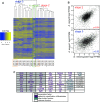Evolution of maternal and zygotic mRNA complements in the early Drosophila embryo
- PMID: 30557299
- PMCID: PMC6312346
- DOI: 10.1371/journal.pgen.1007838
Evolution of maternal and zygotic mRNA complements in the early Drosophila embryo
Abstract
The earliest stages of animal development are controlled by maternally deposited mRNA transcripts and proteins. Once the zygote is able to transcribe its own genome, maternal transcripts are degraded, in a tightly regulated process known as the maternal to zygotic transition (MZT). While this process has been well-studied within model species, we have little knowledge of how the pools of maternal and zygotic transcripts evolve. To characterize the evolutionary dynamics and functional constraints on early embryonic expression, we created a transcriptomic dataset for 14 Drosophila species spanning over 50 million years of evolution, at developmental stages before and after the MZT, and compared our results with a previously published Aedes aegypti developmental time course. We found deep conservation over 250 million years of a core set of genes transcribed only by the zygote. This select group is highly enriched in transcription factors that play critical roles in early development. However, we also identify a surprisingly high level of change in the transcripts represented at both stages over the phylogeny. While mRNA levels of genes with maternally deposited transcripts are more highly conserved than zygotic genes, those maternal transcripts that are completely degraded at the MZT vary dramatically between species. We also show that hundreds of genes have different isoform usage between the maternal and zygotic genomes. Our work suggests that maternal transcript deposition and early zygotic transcription are remarkably dynamic over evolutionary time, despite the widespread conservation of early developmental processes.
Conflict of interest statement
The authors have declared that no competing interests exist.
Figures







References
Publication types
MeSH terms
Substances
Grants and funding
LinkOut - more resources
Full Text Sources
Molecular Biology Databases

